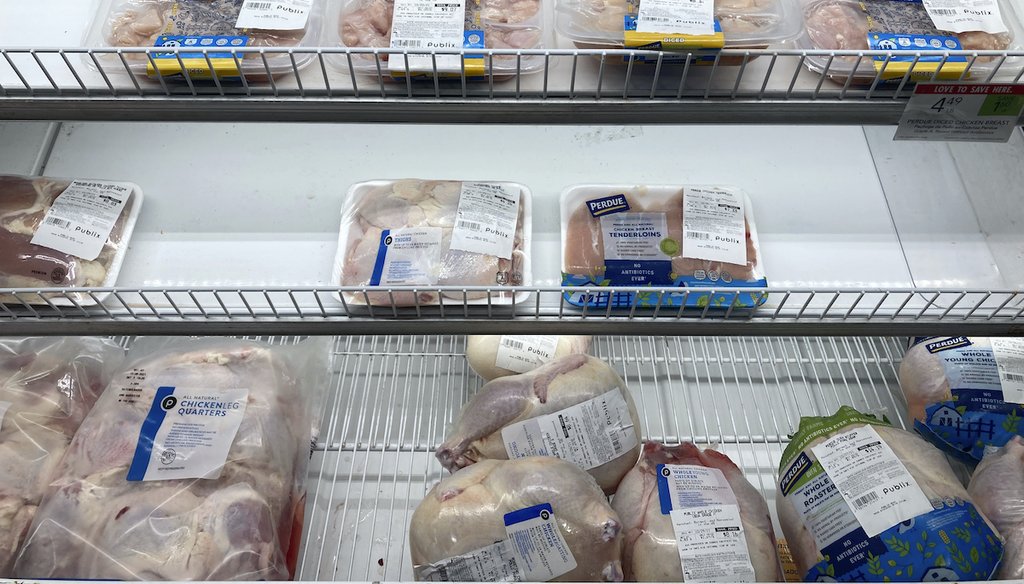



A near empty case of different chicken cuts is displayed at a Publix Supermarket, Wednesday, Oct. 20, 2021, in Miami. (AP)
A sealed packaged bag of raw chicken that appears puffy "is not an indicator of spoilage," according to the trade association National Chicken Council.
Food safety is so important in the U.S. that there are entire parts of government designed to keep people safe from what they consume.
The U.S. Department of Agriculture and the Food and Drug Administration offer all kinds of advice about how to avoid foodborne illness. Wash hands. Keep raw foods separated from other foods. Thoroughly cook meat.
Not on the list: Avoid buying poultry in puffy looking bags. But that hasn’t stopped the internet from issuing its own warnings.
"PSA: Air in bags of meat is not normal! Don’t eat it!!!" reads text across a Facebook video posted Oct. 13. The video hovers over a grocery store cooler filled with bagged chicken as a man pokes one of the sealed bags, which has become somewhat inflated, and tells viewers that he was hospitalized after consuming protein in similar packaging.
"When the bag is puffy like that, it means bacteria has started growing in there…Don’t buy it!" the video’s caption reads.
The post was flagged as part of Instagram’s efforts to combat false news and misinformation on its News Feed. (Read more about our partnership with Meta, which owns Facebook and Instagram.)
Verify This checked this claim in 2021 and found it to be wrong. That hasn’t changed.
A National Chicken Council spokesman told PolitiFact that if a sealed packaged bag of raw chicken appears puffy, "this is not an indicator of spoilage.
"This is a USDA-approved packaging process, and there is no food safety concern, said Tom Super, spokesperson for the trade association. "The puffiness of the bags actually indicates the packaging is properly sealed. The best indicators of spoilage would be the Sell By or Use By date, discoloration, foul smell and/or leakage, not the particular packaging."
According to the USDA's official packaging and distribution guidelines, bag puffiness can result from a process called "controlled atmosphere packaging."
Packaging manufacturers replace some or all of the oxygen inside the bag or package with gases such as carbon dioxide or nitrogen to preserve the raw poultry, according to the guidelines. Otherwise, "oxygen in the air hastens both the chemical breakdown and microbial spoilage" of the protein, the USDA’s website says.
In other words, the more exposure to oxygen, the hastier the breakdown.
The USDA further advises that the best way to assess whether poultry is safe for cooking is to inspect its physical appearance, scent and color.
"In addition to the color change, the meat or poultry will have an off odor, be sticky or tacky to the touch, or it may be slimy," the USDA says on its website. "If meat has developed these characteristics, it should not be used."
A viral Facebook video claimed sealed bags of raw poultry that appear taut or "puffy" are indicative of spoilage, making the protein unsafe to consume.
That’s false, according to USDA regulatory guidelines for packaging. Puffy packaging is generally an indicator the distributor used controlled atmosphere packaging, in which oxygen is supplemented with carbon dioxide or nitrogen.
We rate this claim False.
Facebook Reel (archived), accessed Oct. 13, 2022
Email interview with National Chicken Council spokesman Tom Super, Oct. 14, 2022
U.S. Department of Agriculture, "The Color of Meat and Poultry," accessed Oct. 14, 2022
U.S. Department of Agriculture, "Meat and Poultry Packaging Materials," accessed Oct. 14, 2022
National Chicken Council, Overview and informational landing page, accessed Oct. 14, 2022
Verify This, "Viral video claims frozen chicken in puffed-up bags is spoiled. That's false," Dec. 6, 2021
In a world of wild talk and fake news, help us stand up for the facts.
